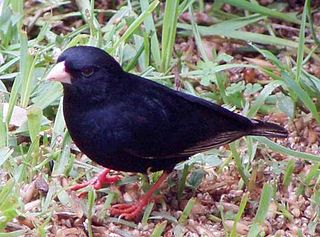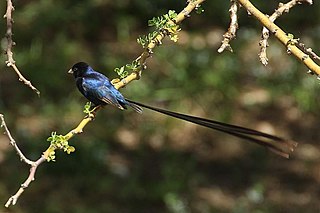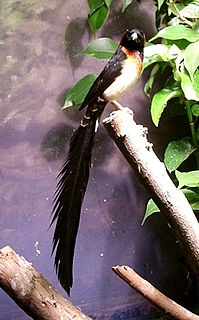
Vidua is a genus of passerine birds in the family Viduidae.

The pin-tailed whydah is a small songbird with a conspicuous pennant-like tail in breeding males. It is a resident breeding bird in most of Africa south of the Sahara Desert.

The long-tailed paradise whydah or eastern paradise whydah is from the family Viduidae of the order Passeriformes. They are small passerines with short, stubby bills found across Sub-Saharan Africa. They are mostly granivorous and feed on seeds that have ripen and fall on the ground. The ability to distinguish between males and females is quite difficult unless it is breeding season. During this time, the males molt into breeding plumage where they have one distinctive feature which is their long tail. It can grow up to three times longer than its own body or even more. Usually, the whydahs look like ordinary sparrows with short tails during the non-breeding season. In addition, hybridization can occur with these paradise whydahs. Males are able to mimic songs where females can use that to discover their mate. However, there are some cases where females don't use songs to choose their mate but they use either male characteristics like plumages or they can have a shortage of options with song mimicry. Paradise whydahs are brood parasites. They won't destroy the eggs that are originally there but will lay their own eggs in other songbirds nest. Overall, these whydahs are considered least concerned based on the IUCN Red List of threatened species.

The shaft-tailed whydah or queen whydah is a small, sparrow-like bird in the genus Vidua. During the breeding season the male has black crown and upper body plumage, golden breast and four elongated black tail shaft feathers with expanded tips. After the breeding season is over, the male sheds its long tail and grows olive brown female-like plumage.

The chestnut-breasted mannikin, also known as the chestnut-breasted munia or bully bird, is a small brown-backed munia with a black face and greyish crown and nape. It has a broad ferruginous breast bar above a white belly. The species is found in Australia, New Caledonia, Indonesia, and Papua New Guinea. This species has also been introduced to French Polynesia and France.
Plasmodium octamerium is a parasite of the genus Plasmodium subgenus Giovannolaia.

The cuckoo-finch, also known as the parasitic weaver or cuckoo weaver, is a small passerine bird now placed in the family Viduidae with the indigobirds and whydahs. It occurs in grassland in Africa south of the Sahara. The male is mainly yellow and green while the female is buff with dark streaks. The eggs are laid in the nests of other birds.

The white-collared monarch is a species of bird in the family Monarchidae. It is found in the Solomon Islands of Ugi and Makira.

The African pied wagtail, or African wagtail, is a species of bird in the family Motacillidae.

The dusky indigobird, variable indigobird, or black widowfinch is a species of bird in the family Viduidae. It is found in Angola, Burundi, Cameroon, Republic of the Congo, Democratic Republic of the Congo, Guinea-Bissau, Malawi, Mozambique, Nigeria, Sierra Leone, South Africa, Swaziland, Tanzania, Zambia, and Zimbabwe. Its natural habitat is moist savanna.

The steel-blue whydah is a species of bird in the family Viduidae. It is found in Ethiopia, Kenya, Somalia, South Sudan, Tanzania, and Uganda. Its natural habitat is dry savanna.

The exclamatory paradise whydah or Uelle paradise whydah is a species of bird in the family Viduidae. It is also known as the long-tailed paradise whydah, a name which can refer to Vidua paradisaea.

The broad-tailed paradise whydah is a species of bird in the family Viduidae. It is found woodland and acacia savanna habitat in Sub-Saharan Africa from Angola to Uganda, Tanzania and Mozambique. A brood parasite, it has a wide range and the International Union for Conservation of Nature has assessed it as being of least concern.

The purple indigobird is a species of bird in the family Viduidae. It is also known as the dusky indigobird, a name which can refer to Vidua funerea. It is found in Angola, Botswana, Democratic Republic of the Congo, Kenya, Malawi, Mozambique, South Africa, Tanzania, Zambia, and Zimbabwe. Its natural habitat is dry savanna.
The Togo paradise whydah is a species of bird in the family Viduidae. It is found in Benin, Cameroon, Chad, Ivory Coast, Ghana, Mali, Sierra Leone, and Togo.

The Sahel paradise whydah, yellow-naped whydah or northern paradise whydah is a small songbird.
Five species of indigobird are known as paradise whydah:















